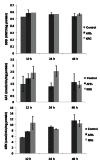Protective Effect of Korean Red Ginseng against Aflatoxin B1-Induced Hepatotoxicity in Rat
- PMID: 23717067
- PMCID: PMC3659521
- DOI: 10.5142/jgr.2011.35.2.243
Protective Effect of Korean Red Ginseng against Aflatoxin B1-Induced Hepatotoxicity in Rat
Abstract
Korean red ginseng (KRG), the steamed root of Panax ginseng Meyer, has a variety of biological properties, including anti-inflammatory, antioxidant and anticancer effects. Aflatoxin B1 (AFB1) produced by the Aspergillus spp. causes acute hepatotoxicity by lipid peroxidation and oxidative DNA damage, and induces liver carcinoma in humans and laboratory animals. This study was performed to examine the protective effects of KRG against hepatotoxicity induced by AFB1 using liver-specific serum marker analysis, histopathology, and terminal deoxynucleotidyl transferase-mediated dUTP nick-end labeling. In addition, to elucidate the possible mechanism of hepatoprotective effects, superoxide dismutase, catalase, glutathione peroxidase, and malondialdehyde were analyzed. Rats were treated with 250 mg/kg of KRG (KRG group) or saline (AFB1 group) for 4 weeks and then received 150 μg/kg of AFB1 intraperitoneally for 3 days. Rats were sacrificed at 12 h, 24 h, 48 h, 72 h, or 1 wk after AFB1 treatment. In the KRG pre-treatment group, serum alanine aminotransferase, aspartate aminotransferase, and malondialdehyde levels were low, but superoxide dismutase, catalase, and glutathione peroxidase activities were high as compared to the AFB1 alone group. Histopathologically, AFB1 treatment induced necrosis and apoptosis in hepatocytes, and led to inflammatory cells infiltration in the liver. KRG pre-treatment ameliorated these changes. These results indicate that KRG may have protective effects against hepatotoxicity induced by AFB1 that involve the antioxidant properties of KRG.
Keywords: Aflatoxin B1; Antioxidant enzymes; Korean red ginseng; Panax ginseng.
Figures





References
-
- Metcalfe SA, Colley PJ, Neal GE. A comparison of the effects of pretreatment with phenobarbitone and 3-methylcholanthrene on the metabolism of aflatoxin B1 by rat liver microsomes and isolated hepatocytes in vitro. Chem Biol Interact. 1981;35:145–157. doi: 10.1016/0009-2797(81)90139-3. - DOI - PubMed
-
- Judah DJ, Hayes JD, Yang JC, Lian LY, Roberts GC, Farmer PB, Lamb JH, Neal GE. A novel aldehyde reductase with activity towards a metabolite of aflatoxin B1 is expressed in rat liver during carcinogenesis and following the administration of an anti-oxidant. Biochem J. 1993;292(Pt 1):13–18. - PMC - PubMed
LinkOut - more resources
Full Text Sources
Miscellaneous
